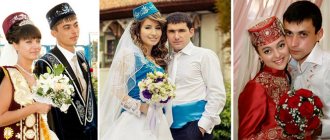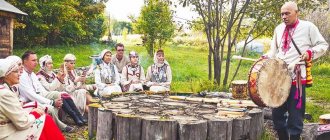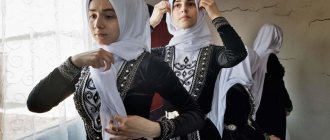Origin of the people
Did you know that the history of the birth of Armenia is described in Biblical legends. The founder's name was Hayk, he was the great-great-grandson of the famous Noah. The young man was handsome and strong, and together with his people he took part in the construction of the Tower of Babel. Afterwards, he went to his native lands, bequeathed by his father.
Defending the right to found his own state, he went to war with Bell and won. At the site of the battle, a city was built, named after the winner.
Hayk lived until 2026 BC, after which the country was led by his son named Armenak. During his reign, he expanded the borders, annexed a number of tribes and gave the state the name Armenia.
Religion
Since 301, Christianity has been officially the state religion. And the first communities that professed it appeared in the 1st century AD. The Armenian Church is not similar to the Catholic and Orthodox, and is different:
- Unity.
- Architecture (oriental shades)
- Rituals, fasts, religious holidays.
- Relationship to Jesus Christ. In Orthodoxy, his personality is attributed to two principles: divine and human. The Armenians have one.
There are also Catholics, Orthodox Christians, and Muslims present in the country, but their total number does not exceed 5% of all believers.
You can't look bad in front of your husband
Any Armenian woman should be not only a good housewife, an exemplary mother, but also a great wife. Her appearance in front of her husband in an unsightly form is unacceptable.
"Dad is offended." Agata Muceniece about her relationship with Priluchny after the divorce
Smooth and fresh skin: dermaplaning, or why a woman needs to shave her face
Lost weight: what Sofia Tarasova sacrificed for the sake of “VIA Gra” (new photos)
Even the most charming and beautiful woman blossoms even more so that a man can admire and admire her.
It is worth noting that the cult of beauty among Armenian women is very developed. They try to carefully follow fashion and not go out without good makeup.
Traditional Armenian housing
The ancient houses of this people will surprise any European. Imagine, they made the roof from earth poured onto wooden pillars. The walls were built of stone, and the windows were located at the top, on the ceiling.
In the center of the square house, on a raised platform, there was a fireplace. Along the walls there were ottomans that served the owners instead of beds. And the niches were closed with wooden doors and served as cabinets. The open shelves displayed pottery and kitchen utensils.
Return to contents
Family Armenian traditions
A tree is strong if it has strong roots. Gayk's descendants cherish their roots. Armenian traditions and customs in the family are based on laws passed down from generation to generation.
Respect for elders
A special attitude towards grandfathers is instilled with mother's milk. This is manifested in behavior by following the rules:
- Don't make noise in the presence of elders.
- Don't argue.
- Stand up when an older person enters the room.
- Give way.
- Show attention at the table (fill a glass, serve a dish, etc.)
Armenian hospitality
Generous people, ready to host anyone, even an uninvited guest. A rich table, hospitable hosts, a comfortable bed are irreplaceable attributes of the hospitality of the Armenians, which has made them famous throughout the world.
By sharing shelter and food, they share happiness. And happiness given to others is returned threefold. To refuse an invitation to the table means to offend the host.
Traditions associated with the birth of a child
In the country, large families are the norm. Every little person is rejoiced, protected and pampered with gifts. Prepare for the birth of a child in advance. Despite the happiness, the baby is hidden from prying eyes for 40 days from his birth. It is noteworthy that after giving birth, before entering the temple with the baby, the mother must cleanse herself.
Interesting rituals associated with the birth of a baby:
- A pregnant woman should not communicate with women who have not given birth.
- It was forbidden to visit the wife's parents during pregnancy.
- If the birth was difficult, the men living in the house would shoot out the window with a gun, scaring away the evil forces.
- After birth, the baby was sprinkled with salt.
- If strangers came to the house before 40 days, the newborn was picked up and carried out into the yard.
- Baptism took place on the 8th day. The mother was not allowed. After the ceremony, the godfather returned the child to the woman. She kissed his hands first, then his feet.
Refusal to farm
Armenians are very hospitable people, and the women in the house are always responsible for the richness of the table. Not a single Armenian woman can give up housekeeping (and this is not just about cooking).
As a rule, Armenian women have time to clean the house, create warmth and comfort, and prepare delicious food - they usually do not work, because the man earns the money.
The money tree pleases with lush flowering: my secret is in caring for the leaves
“We are still friends”: Derevianko commented on the breakup with his wife
Why French children behave well: eight ways to raise them
Armenian cuisine
Did you know that Armenian cuisine is one of the oldest in the world, which has preserved many recipes and traditions to this day. Distinctive features of the dishes:
- An abundance of herbs and spices.
- High salt content.
- Complex cooking process. Combining different cooking methods in one dish.
- Widespread use of meat. Unusual combination of ingredients.
- Preference for ghee over vegetable oil.
They also eat vegetables, legumes, and grains.
Return to contents
Armenian wedding
Previously, the celebration was celebrated for at least 7 days. The whole village walked. The preparation process for this event could take up to 2 years. Now many traditions are gone, some have been simplified. But there are places where a large proportion of rituals are observed, which we will discuss below.
Ceremony
It all starts with collusion. Men, representatives of the groom go to the girl’s parents. If the relatives have agreed, after a while matchmakers are sent to the bride’s house. It is interesting that previously the mother-in-law chose the future wife for her son, and only then discussed the candidacy with his father and grandfather.
A girl was allowed to get married at 12 years old. The young man had to get on his feet and provide for his family. Therefore, men did not marry until they were 23–24 years old.
Given the religiosity of the people, the main ceremony was the wedding. Civil registration was sometimes carried out years later, and only if there was such a need (birth of a child, legal issues).
Feast
Modern Armenians celebrate weddings more modestly than their ancestors. But the celebration is still on a grand scale. They begin to celebrate separately. The table is set in the groom's house, friends and relatives wish him happiness. Then, the procession heads to the girl's house. After paying off the bride, she was handed over to her husband. At the same time, sad music was playing, the mother and friends were wailing and singing folk farewell songs.
Having completed the wedding, the guests went to the groom, where they continued the feast. Nowadays, young people go to a restaurant.
Blessing
The groom's mother blesses the newlyweds. In the old days, she was not allowed to attend the sacrament, and waited for the children at the entrance to the house. Now the mother-in-law can attend the ceremony, but before the feast begins, the woman meets the newlyweds at the door with lavash and honey (just like Russians do with bread and salt). She wishes happiness, says parting words.
Post-wedding customs and traditions
After the festivities, rituals were observed:
- Confirmation of the bride's innocence. In the morning messengers came to the young people. If the girl maintained her purity before the wedding, the groom gave the messengers a red apple. It was shown to everyone.
- Washing your head. For a whole week, the mother-in-law is not allowed to visit the newlyweds. After 7 days, she brings the girl everyday clothes, personal hygiene items, and helps wash her hair.
- Sending dowry.
- Darts - the return of a young wife to her father’s house to stay. The acceptable period is from 2 weeks to a month.
Return to contents
The place of a son-in-law in an Armenian home
Armenian family traditions and customs, as a rule, do not accept the possibility of a young family living with the wife’s parents, mother-in-law and father-in-law. There is even a disparaging nickname - “house son-in-law”, which is given to young men who, after marriage, move to their wife’s father’s house. But this custom is often violated today, because sometimes city girls marry provincials who come from the regions, who, as a rule, do not have their own home. And of course, the young wife does not want to go far away to the house of her husband’s parents, and the newlyweds remain to live in the wife’s house.
Traditional Armenian holidays
Holidays in Armenia are amazing and emotional. Going to the festivities these days is an unforgettable experience for Europeans.
Vardavar
The holiday is based on a beautiful pagan legend about how the god of the underworld kidnapped the goddess of love Astghik and locked him away. The world plunged into darkness, love disappeared from people's hearts. But the thunder god Vahagn freed his beloved. Returning to the ground, Astghik splashed water and rose petals on everything. So love settled in our hearts again.
With the advent of Christianity, people stopped believing in pagan deities, but they did not want to cancel the beautiful and cheerful holiday. Then it was timed to coincide with the day of the Transfiguration of the Lord and began to be celebrated on the 14th Sunday after Easter.
On Vardavar, from early morning, people give roses to those they feel affection for and pour water on everyone. And it doesn’t matter who is in front of you, a poor man or a man in a rich suit. You can pour water on everyone, as long as you have dishes in your hands.
Metsi Pagk (Lent)
Abstinence from meat, milk, fish lasts 40 days. This is similar to the fast that Orthodox Christians observe before Easter. The Armenians were allowed to relax on Sundays. And the Tsaghkazard holiday is similar to Palm Sunday. By the way, Armenians also paint eggs and exchange them on Easter.
holy cross
There are a total of 4 holidays in Armenia related to the cross. The main one is Khachverats. It is celebrated on Sunday, from September 14 to 17, and is dedicated to the return of the Life-giving Cross of Christ in 614 to Jerusalem. Among the troops that recaptured the shrine from the Persians was an Armenian regiment, so the holiday is the national pride of the people.
Armenian Christmas Surb Sargis
Christmas celebrations take place from January 5 to 6 and coincide with Epiphany. The Armenian Church is faithful to traditions and has undergone minimal changes compared to the Catholic and Orthodox Church. In ancient times, all Christians celebrated the birth of Jesus from 5 to 6.
Why is Epiphany celebrated on this day? The Bible says that Christ was baptized and began preaching at the age of 30. It is logical to assume that the ceremony was performed on the day of his anniversary.
Barekedan Festival
Time for jokes and fun. Starts two weeks before Metsi Pagk. All 14 days pass with laughter.
Return to contents
Pentecost
The holiday has something in common with the Orthodox. 50 days after Easter, the Holy Spirit descended on the apostles. As a result, Christ's disciples were able to speak different languages and preach in every corner of the world. Pentecost does not have a fixed date; the time of celebration depends on Easter. Next begins the Ilyinsky fast of 5 days.
Armenian holiday Ambartsum
Celebrated on the 40th day after Holy Sunday. In Russia this celebration is called the Ascension of the Lord. Doves are released into the sky, following them with their gaze until the birds disappear from sight. Also, the night before, the girls weave wreaths and collect water from 7 springs in jugs. The next morning, the liquid in the vessels is blessed.
Matah - sacrifice
The tradition of animal sacrifice is described in the Old Testament. The Armenians have preserved it to this day, albeit with changes.
In honor of devotion to the Almighty, Matah is held as gratitude for help or a request for assistance. A male domestic animal (not a pig) was allowed to be slaughtered. The meat was cooked by adding sacred salt. Then they distributed it to the poor. Only the pigeon is not killed. It is enough to release it into the sky.
| Matah is not a symbol of knackering or paganism. This is how the people show that they are ready to sacrifice for the glory of God. |
Saint Vardanav's Day
The holiday has historical and religious roots. This is the date when everyone united in the struggle for freedom, for the Christian faith: old people, children, women, those who could stand and hold weapons. Many died, too many to count, but the people survived and the faith was preserved.
The event took place in the 5th century, and it is celebrated 8 weeks before Easter. Vardanants became the head of a strong, unified regiment. He fell in battle, but retained his memory for centuries. The holiday was named in his honor.
Day of St. Gregory, Enlightener of Armenia
At the beginning of the 3rd century, there were both Christians and pagans in Armenia. St. Gregory was a Christian. But King Trdat III, who ruled in those years, was a pagan. Gregory spent about 13 years in the royal prison, because he was considered a traitor and a spy. But one day, Trdat III fell ill.
No one could cure him, and only the “traitor” imprisoned in prison, turning to God, healed the ruler. The king believed in the Lord, and Christianity officially became the state religion of the country.
The saint is venerated on September 30.
Armenian Easter “Zatik”
Easter is a great holiday for all Christians, and the Armenian people are no exception. Interesting Easter traditions in Armenia:
- For 40 days, at the beginning of Lent, dolls are made from straw. One of them has 40 threads with pebbles at the end in her hands. Every day the owners untied one, which helped count the time until the holiday.
- Before Easter, the tree is decorated. This means that it brings good luck.
- The eggs are painted only red, on Sunday they are knocked against them and changed, just like the Russians.
- Armenians also bake Easter cakes.
Tyryndez
Holiday of the young and lovers. The roots go back to pagan times. The Christian Church transformed it, combining it with the Meeting of the Lord. The day Jesus was first brought into the temple. Celebrated on February 13th. Services are held in churches. And in the evenings, young couples jump over the fire.
| If the clothes catch fire, it’s a good sign that bad luck will burn. The day ends with a feast and eating sweets. |
Is it easy to be a woman in Armenia?
© RIA Novosti
One of the common misconceptions of modern Armenian society is that our Armenian men are distinguished by a respectful, gentlemanly attitude towards the fairer sex and have exceptional skills in dealing with women. This myth is actively spread by men themselves: most of them, at every convenient and inconvenient occasion, transparently hint that they are special experts in dealing with the female sex. The story of an Armenian man about how to properly care for a girl, how to seduce her and leave her beautifully, can be heard in our country as often as getting caught in the rain in London.
However, representatives of the fair sex are not particularly sensitive to such myths due to female realism, and not only that. Women experience from their own experience how the mythical knowledge about gentlemanship does not find its practical embodiment, at least the majority of Armenian women have not seen this.
Virginity at any age
Instead, the beautiful half of the Armenian population has to try hard to please the gentlemen of Armenian origin described above. We are talking about premarital virginity as a cultural code of modern Armenia, and it doesn’t matter whether the bride is 19, 25 or 30 years old, the bride must maintain her virginity before the wedding. There is no need to talk about the fact that a woman, excuse me, is also a person and, oh, horror, intimacy can happen. Everyone, welcome to the ranks of “unrespectable girls.”
The notorious theme of the “red apple” in Armenia excites the minds of the entire population. On the one hand, gynecologists are tired of talking about the harm caused to women's health by neglecting sexual life. And in general, it seems like times are not the same now. On the other hand, mothers and girlfriends of both boys and girls unanimously assert that without virginity, no one needs the most beautiful and intelligent girl for nothing. In Armenia, the rule of choosing a marriage partner by parents is no longer mandatory, but parents must guarantee that their daughters do not have premarital affairs, and the mother-in-law must confirm the presence of evidence of defloration after the wedding night. Of course, there are exceptions, inspired by the winds of change and the temptation of liberal values. They can often be observed in the capital, but for any self-respecting inhabitant of a provincial town, not to mention remote villages, all this is a complete disgrace for the whole family.
Of course, no one abolished family values, decency, home and so on, but who said that a woman, a girl who does not fit into the generally accepted and, frankly speaking, outdated social stereotype cannot a priori be a worthy wife? At the same time, the girl should be understanding - in the sense of submissive, obedient, but at the same time she should not be smart, otherwise the sweetheart will have a complex compared to his smart wife.
If fate turned out to be favorable to the girl and she ended up marrying her prince (I don’t know why, but in Armenia a girl must get married, preferably before 25), she should be understanding if her husband leaves, sorry, to the left. Such trips have acquired the status of a taken-for-granted event simply because he is a man and he is supposed to. Women, on the contrary, are limited in communication, movement, and the ability to work outside the home. Their sexual life is identified with reproductive function and is controlled at all stages of the life cycle.
Armenian woman at the intersection of problems
Today, in order to understand how a modern Armenian woman lives, what difficulties she faces and what successes she has achieved, numerous Western organizations conduct dozens of studies that poorly reflect the true state of affairs.
According to the National Statistical Service of Armenia, 1 million 684 thousand women live in the country, 100 thousand more than men, which is 51.5% of the total population of the republic. For the most part, these are educated (often with two higher education), able-bodied girls and women. But this does not prevent the country from very badly exploiting such a rich female resource. Among the 18 members of the government, there are only 2 women - Minister of Culture Hasmik Poghosyan and Minister of Diaspora Hranush Hakobyan. Women make up 9.2% of the Armenian parliament (12 out of 131 deputies), despite the fact that during the 2007 elections, political parties introduced a 15% minimum quota for women elected through party lists. In the middle and low levels of the state apparatus, women make up the majority. At the same time, according to research, factors hindering women’s political involvement are: women’s focus on family (45.2%); women's lack of confidence in their own abilities (35.1%); public distrust of female politicians (33.5%); lack of mechanisms for promoting women (29.2%); negative position of relatives (spouse, parents) (28.3%).
At the legislative level in Armenia, women's rights are protected quite strongly. However, it is not for nothing that Armenia is famous for its liberal legislation; the extent to which these laws are implemented in practice is another question.
In reality, Armenian girls are faced with gender inequality even while studying at universities, since the majority of graduate students are admitted to boys, so that the latter can avoid the army. As a result, the ratio of unemployed men to women is approximately 60 to 70, and this despite the fact that women in Armenia are ahead of men in terms of education. And women earn almost half as much, although the advertisements mainly require young and preferably unmarried girls to work.
A particularly painful problem for Armenian society in the context of gender inequality is selective abortion. Every self-respecting Armenian man dreams of a son who will continue the family name and, naturally, the clan. The desire of future parents to have a son rather than a daughter very often becomes the reason for selective abortion, so it is not by chance that Armenia is one of the three leading countries in terms of the number of selective abortions.
Hidden matriarchy
Despite the fact that Armenian men are all serious and businesslike, most of them walk under the heel of their wives, completely without noticing it. The tactics remind me of controlled democracy with elements of manipulation brought to the point of virtuosity. Nothing in the house of an Armenian woman will move forward without the consent of the wife or mother: from buying a dishwasher to issues of political choice. And this despite all the outward apoliticality of Armenian women. An outwardly independent and self-sufficient Armenian man will not do anything without asking his wife and especially his mother.
Instead of the glorified patriarchal Armenian family, we see the so-called hidden matriarchy performed by wise Armenian women, who, despite their indifferent political views, by virtue of their capabilities, determine the conservative course of development of the Armenian state, which is still bypassed by revolutionary waves.
But an Armenian man will never admit this publicly. He, along with his older female relatives, will demand virginity from matured 25-year-old brides and go to a restaurant in an all-male company, because a decent wife should stay at home.
New Year celebration
If you adore this holiday, come to Armenia, there are 3 of them:
- Official - from December 31 to January 1. Introduced in the 18th century, at the behest of the church. It’s interesting that children’s gifts are not placed under the Christmas tree, but in their stockings.
- 21 March.
- In the summer, August 11.
New Years 2 and 3 are associated with paganism and are not recognized by the church. But will this stop people? So if you thought that the Russian “Old New Year” was the coolest, you were mistaken. Armenians have one more holiday.
Return to contents
Winemaking and cognac production
It was in Armenia, after the global flood, that the biblical figure Noah planted a grapevine. Since then, the land has become the capital of winemaking. Previously, berries were crushed with feet in a special stone structure. Now the technology has improved. But many families, as well as industrial enterprises, are still involved in wine production. Made from grapes, fruits, berries.
Famous brands:
- Zorah.
- Arame.
- Voskeraz.
- Areni.
Cognac began to be produced later. The quality of the Armenian drink was famous not only in the USSR, but also in the West. The following are very popular:
- Arvest.
- Armenia.
- Bagrat.
- Yerevan.
- Ararat.
All cognac is divided into:
- Vintage. The drink can be stored for years (from 6 and above). Quality explains the high price. The longer the shutter speed, the more expensive it is.
- Collectible.
- Ordinary. It is often sold in stores.
Did you know that the number of stars on bottles of ordinary cognac indicates how many years the spirits were aged in barrels.
Funeral traditions
Funerals in Armenia have much in common with Russian customs. Rituals specific to the Armenian people:
- On the day of the funeral, they knock three times on the door of the house where the deceased lies, and the coffin is raised and lowered three times. This is necessary so that death does not take anyone else from home.
- Red carnations are scattered before the procession.
- At the cemetery, women are the first to say goodbye.
- Funeral services are organized after the funeral, as well as after 7 and 40 days.
At the wake, relatives and friends wear black mourning clothes.
Funeral customs
Almost all peoples of the world have special rituals that add solemnity to the process of human burial. It is difficult to briefly describe all the customs and traditions of the Armenian people, especially when it concerns the saddest moments of our lives - saying goodbye to a loved one. At the same time, being Christians, Armenians honor all church rituals. That is, the deceased is buried either in church or in his home in the presence of all relatives and friends. At the same time, not only people who personally knew the deceased, but also friends, acquaintances and colleagues of his family members go to the memorial service.









